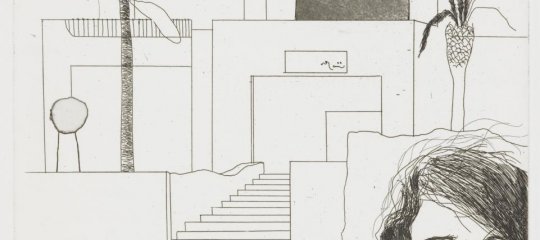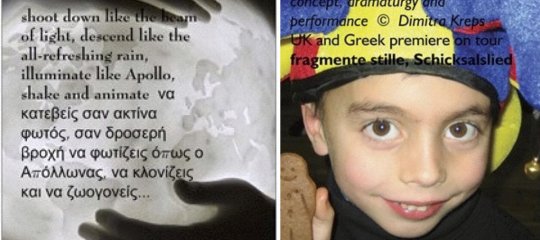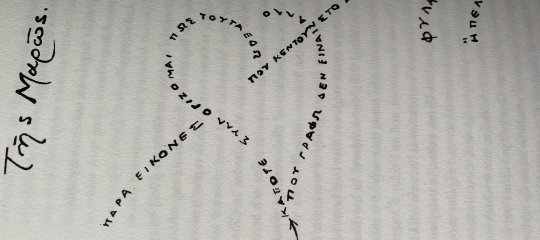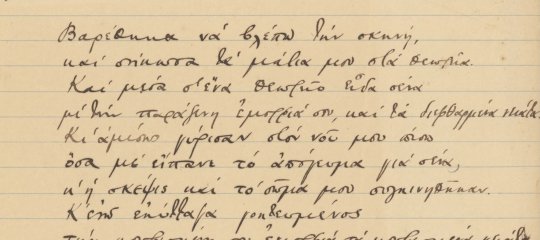Οι μεταφράσεις της Ι.Καβαλιόβα
MihalisPatsis writes, "Μιχάλης Πάτσης
Οι μεταφράσεις της Ιρίνας Καβαλιόβα
Η Ιρίνα Καβαλιόβα τα τελευταία χρόνια με μεγάλη φροντίδα και προσωπικό μόχθο προσπαθεί να γνωρίσει το ρωσικό κοινό με ξεχωριστά κείμενα της νεοελληνικής ποίησης. Νομίζω η προσπάθειά της είναι όχι μόνο άξια λόγου αλλά και πολύ σημαντική, γιατί αν κατανοήσουμε τις δυσκολίες που συναντούν τα νεοελληνικά κείμενα στην σημερινή Ρωσία θα καταλάβουμε πως το μεταφραστικό της έργο, δεν εντάσσεται μόνο με μια καθαρά φιλολογική ενασχόληση αλλά και γενικότερα αποτελεί στοιχείο πολιτισμού και διαπολιτισμικής επικοινωνίας για την Ελλάδα και τη Ρωσία.
"
21 Φεβρουαρίου 2005
Αφορμή γι’ αυτό το σημείωμα στάθηκε μια τελευταία της μεταφραστική της δουλειά πάνω στην ποίηση του Γιώργη Παυλόπουλου που δημοσιεύθηκε στο περιοδικό «Ξένη Λογοτεχνία» ένα περιοδικό με παράδοση και κύρος. Το να αγοράζεις ένα περιοδικό και να βλέπεις ποιήματα του Παυλόπουλου στα ρωσικά είναι ιδιαίτερα ευχάριστο αλλά και ενθαρρυντικό τουλάχιστον. Σκοπός μου είναι να μιλήσω σύντομα για το έργο και τη μέθοδό της.
Η Ιρίνα Καβαλιόβα έχει μεταφράσει τους εξής έλληνες ποιητές: Ο. Ελύτη «Άσμα ηρωικό και πένθιμο για τον χαμένο ανθυπολοχαγό της Αλβανίας», Κ. Καβάφη πολλά ποιήματα που έχουν μπει στο συλλογικό τόμο «Ρωσική Καβαφιάνα», Μ. Σαχτούρη, τα πεζά του Καβάφη καθώς και μέρος από τις Δοκιμές του Γ. Σεφέρη, ποιήματα του Μιχάλη Πιερή. Τώρα μετέφρασε Γ.Παυλόπουλο, πιο συγκεκριμένα στο περιοδικό που έχω μπροστά μου υπάρχουν επτά ποιήματα από τη συλλογή του «Αντικλείδια» και πέντε ποιήματα από την συλλογή «Που πήγαν τα πουλιά;»
Στις παρουσιάσεις Ελλήνων ποιητών ακολουθεί την εξής μέθοδο:
1. Προσπαθεί να βρει τη δυνατότητα επικοινωνίας που έχουν αυτοί με τους ποιητές Κ. Καβάφη και Γ. Σεφέρη. Η διακειμενικότητα ως προς αυτούς τους δύο, ως κεντρικές μορφές της ελληνικής ποίησης ακολουθεί τις μεταφράσεις ποιημάτων που κάνει. Αυτό γίνεται για δύο λόγους, πρώτον για να εντάξει τους ποιητές στην ελληνική ποίηση χωρίς να καταπιάνεται με ξερές περιοδολογήσεις και δεύτερον για να τους γνωρίσει καλύτερα με το ρωσικό κοινό, αφού αυτό γνωρίζει σε ένα βαθμό αυτούς τους δύο ποιητές. Όμως δίνει το πορτρέτο του κάθε ποιητή με σαφήνεια, απλότητα και τρόπο που να μπορεί να προσληφθεί και να γίνει κατανοητός.
2. Παρουσιάζει τον ποιητή, ως άνθρωπο αλλά και ως δημιουργό, μιλάει για τη ζωή του τις ασχολίες του, τις πνευματικές αναζητήσεις του και δίνει το ιδιαίτερο στίγμα του, συνυφαίνοντας τη ζωή και το έργο.
3. Προσπαθεί να συνδέσει τον ποιητή με την ευρωπαϊκή αλλά και τη ρωσική πνευματική πραγματικότητα, βρίσκοντας κοινότητα στοιχείων και εκφραστικών μέσων, αναγόμενη σε σχολές και κοινούς επηρεασμούς.
4. Σχολιάζει τα ποιήματα που παρουσιάζει με τον πιο γενικό αλλά και σαφή τρόπο και μόνο εκεί που το θεωρεί αναγκαίο για να γίνει κατανοητό το γενικότερο περικείμενο του ποιήματος αλλά και το ποιητικό σύμβολο να αποκτήσει μεγαλύτερη διαύγεια στη σκέψη του αναγνώστη. Δεν καταπιάνεται με περιττά σχόλια και εκζεζητητημένες λεπτομέρειες αφήνοντας το κείμενο να μιλήσει μόνο του.
5. Η μετάφρασή της υπηρετεί το πρωτότυπο κείμενο και προσπαθεί να είναι όσο το δυνατό πιστή στο ποίημα-πηγή που μεταφράζει. Αυτό ξαφνιάζει ίσως τον αναγνώστη αλλά δημιουργεί και μία διαφορετική επαφή, υπάρχει μια γνωστική υποψία για κάτι διαφορετικό στον μεταφραζόμενο ποιητή. Αυτό το λέω γιατί στη ρωσική ποίηση κυριαρχεί ο παραδοσιακός στίχος, μέτρο και ομοιοκαταληξία και ο Ρώσος αναγνώστης έχει συνηθίσει να διαβάζει τέτοια ποίηση.
6. Όταν θέλει να γράψει τα έργα των ποιητών στην γλώσσα-πηγή τα δίνει με ελληνικούς χαρακτήρες και είναι προσεκτική στη διόρθωση ως το έκδοση, έτσι ώστε να μην υπάρχουν λάθη, αυτό το λέω γιατί συχνά βλέπουμε ελληνικά σε ρωσικές εκδόσεις αλλά με αρκετά λάθη. Δίνει παράλληλα και τη μετάφρασή τους στη ρωσική.
7 Έχω τη γνώμη πως επιδιώκει να προσφέρει στον αναγνώστη ένα ξεχωριστό αίσθημα, ένα αίσθημα ποίησης η οποία στηρίζεται στην λιτότητα ποιητικών μέσων, στην πλήρη κατανόηση του ποιήματος-πηγή, και να δοκιμάσει την αναγνωστική ικανότητα του ρωσικού κοινού σε ποιήματα που δεν περιέχουν επίθετα και παραδοσιακό στίχο.
8. Διατηρεί το «σκελετό» του ποιήματος και προσπαθεί με επιλογή των κατάλληλων λέξεων να δημιουργήσει την αντίστοιχη εντύπωση που προκαλεί το ποίημα στον Έλληνα αναγνωστή.
- Εισέλθετε στο σύστημα για να υποβάλετε σχόλια










